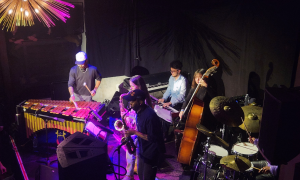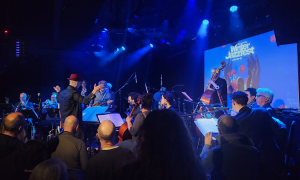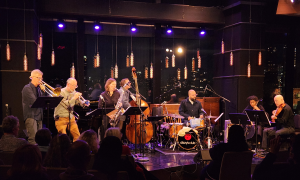Home » Jazz Articles » Live Review » 12 Points 2015
12 Points 2015

What will jazz be like in ten, twenty or fifty years from now? What will be the main influences on it? I think we're hearing the genesis of that in some of the music we're hearing in this festival.
—Kenneth Killeen, Improvised Music Company
Project Arts Centre
Dublin, Ireland
April 15-18, 2015
In an international calendar absolutely bulging with jazz festivals, 12 Points—conceived in Dublin by Improvised Music Company in 2007—stands out as one of the more original. It's not just the diversity and quality of the music that sets Twelve Points apart, after all, there's no shortage of festivals boasting great, eclectic programmes. Nor is it just the fact that 12 Points alternates between Dublin and other European cities, which is unusual in itself. Where 12 Points significantly differs from many other music festivals is it that backs largely unknown bands/artists from across Europe.
Whereas most festivals balk at the idea of risk, 12 Points entices the audience with the risk factor and in the process has developed audiences that come to the music with an open mind to be sure, but expecting innovation and originality. Helping develop the bands' careers and building audiences receptive to music that shies away from codified styles and easy categorization seem to be the twin engines driving the 12 Points juggernaut.
Following another successful jaunt to mainland Europe in Umea 2014, 12 Points 2015 returned to its spiritual home of Dublin, where it all began nine years ago. The four days at the Project Arts Centre served up an amazingly eclectic range of music on its main program and also showcased several of Ireland's most promising young jazz/improvised music outfits.
Recent editions have seen 12 Points expand its purview by gathering together music industry professionals, journalists, and academics to encourage meaningful exchanges and inspire new ideas to promote jazz/improvised music throughout Europe. 12 Points 2015 was no exception. But the real stars of the show were the musicians themselves and there was plenty of compelling, provocative and exciting music to digest.
Day One
Auditive Connection
It can be no easy task to open a festival but Strasbourg four-piece Auditive Connection rose to the occasion with a confident, visceral performance that was as engaging as it was unpredictable. Cellist Anil Eraslan and guitarist Gregory Dargent forged punchy unison riffs and coruscating individual lines over drummer Frédéric Guérin's muscular pop-rock rhythms and vocalist Jeanne Barbieri's idiosyncratic vocal stylings.
On the opener "Monsters" Auditive Connection's music gravitated between King Crimson-like grunge and leaner indie-rock, and although both elements raised their heads from time to time during the set the music was a constantly unfolding mystery. Barbieri's seemingly Latin-sounding liturgy gave way to her invented language vocalisations on "Tontra," a riff-heavy number that included light-hearted shouting, caterwauling and collective Monty Python-esque semaphore. The goalposts were moved again on the episodic "Tra La La" which moved eerily through the gears from neo-classical to psychedelic and noirish universes.
More left-field still, were "Tao Po"—where Barbieri's meditative interpretation of Samuel Beckett's "Texts for Nothing" was bookended by a fierce punk-rock aesthetic—and the brooding closing number, which featured text by Jack Kerouac and—in keeping with the obscure paths Auditive Connection's music went down—a drum solo featuring a towel.
Moskus
The trio of pianist Anja Lauvdal, bassist Fredrik Luhr Dietrichson and drummer Hans Hulbaekmo came together while studying at the Trondheim Conservatory of Music: "It's a very opening method of teaching," said Hulbaekmo before the gig, "you learn about playing from within, not about styles." Accordingly, there was something hermetic about Moskus' internal idiom, one that contained no overt references and which eschewed most typical piano trio conventions.
In an uninterrupted hour, the music's spare architecture evolved slowly. Lauvdal's delicate piano intro gave way to a repeating MIDI-generated mantra, while Hulbaekmo's pattering drums and flickering thumb-piano were accompanied by an insistent bass pulse. Gradually the overlapping waves intensified, creating a powerfully enveloping atmosphere where drone, minimalist pulses and percussive accents converged.
The swell gradually abated after half an hour and a pocket of silence invited hesitant applause. Immediately, the trio pounced on the applauders, sonically that is, and carried on with a lithe free-form improvisation that went from fairly dissonant and rhythmically fractured passages to the sort of flowing invention suggestive of Craig Taborn's trio with William Parker and Gerald Cleaver. A grooving bass ostinato redirected the trio, coaxing Lauvdal to her most melodic phrasing, while Hulbaekmo maintained a delightfully light touch. A processional closing passage, gently upbeat and hymnal, was the first sign of any pre-configured plan.
Many of today's piano trios boast an identifiable sound. Few, like Moskus, are prepared to improvise around sketches of ideas for such prolonged periods. Neither afraid to lock in to an extended riff or to let the music all but expire, Moskus found plenty of inspired moments between the two extremes.
For those curious to hear more check out Moskus' albums Salmesykkel (Hubro Records, 2013) and Mestertyven (Hubro Records, 2014).
STUFF
Not to be confused with the 1970s New York jazz-funk band of the same name, Brussels five-piece STUFF takes its name from the Miles Davis track off the legendary trumpeter's album Miles in the Sky (Columbia, 1968). Any similarities between Davis and this Belgian quintet's music is less about style and more to do with an open approach to music that permits multiple influences to shape the group sound. If Miles in the Sky was a stepping stone for Davis on the transitional path from acoustic jazz to electric, rock-influenced music then what this gig highlighted was how quickly this young quintet has arrived at a strongly identifiable sound—and a potently infectious one at that.
Positioned centre stage, drummer Lander Gyselinck's kit was the fulcrum for the music, his polyrhythmic grooves—in tandem with bassist Dries Laheye—referencing hip-hop, funk, retro pop and futuristic rock. No less central to the dynamics was keyboardist Joris Caluwaerts, whose vibrant sonic colors revisited soulful 1980s synth pop and grooving jazz-fusion from an earlier decade, with the lines often deliciously blurred.
Saxophonist Andrew Claes coaxed myriad textures from his EWI—from low-key punctuation to soaring exclamations—while Menno Steensels' turntables brought an urbane, club edge to the mix. Imagine a super-band—in a parallel universe naturally—that brought together Weather Report, Stevie Wonder, Depeche Mode and Giles Peterson and you may begin to get some idea of STUFF's sonic reach.
Unashamedly retro in some respects, yet with a handle on more contemporary rhythms, STUFF's grooving mash-up was enhanced by the obvious delight the musician displayed, as they seemed to dance with their instruments and the sunny collective vibe. It's easy to imagine STUFF appealing to the Snarky Puppy generation and perhaps enjoying the same international festival appeal. Whether the festivals will have the gumption to present this music in a danceable setting as opposed to the usual sterile theatre/concert hall environment remains to be seen.
Day Two
The medium too, in some cases was also bizarrely retro. It's not known whether any of the record 500 bands/applicants for 12 Points 2015 sent vinyl, floppy discs and cassettes to the organisers but all formats, amazingly enough, were available on the merchandising stand representing the various bands.
As Improvised Music Company's Acting Director Kenneth Killeen explained, 12 Points is realized through an open call to the musicians, conservatories and networks throughout Europe. The incredible response—growing year upon year—highlights the huge number of creative young musicians in every corner of the continent. Some countries, like Norway, the UK, France and Italy, for example, may enjoy higher musical profiles than some other countries but the talent is everywhere.
"Distilling it down to twelve is quite a difficult task but there are really good things happening in Eastern Europe and really good things happening in Budapest," said Killeen by way of introduction to Budapest's A.M.P. Trio, the fortunate one of three Hungarian bands who had made the 12 Points shortlist.
A.M.P. Trio
For fifty uninterrupted minutes pianist Pozsár Máté , bassist Ajtai Péter and drummer Miklós Szilveszter spun an improvised tale that sat somewhere in the free-jazz tradition. The trio's tentative initial steps soon gave way to a confident collective stride. Like some curious three-legged beast, the trio advanced with an inexorable momentum that left strange but lasting impressions.
Máté's frenetic approach to his keys, dissonant and wildly percussive, was matched by the intensity of Péter's thrumming bass and Szilveszter's thunderous attack. Intense, yes, but bass and drums held steady rhythmic courses that anchored the trio even in the headiest passages.
The most fascinating aspect of A.M.P. Trio's music lay not so much in the high peaks of its free improvisation—as passionately stormy and primal as anything Cecil Taylor could muster---but in the climbs up and down in between, where naturally, the pace and intensity undulated. The music was marked not only by a surreptitious progression but by constantly rotating dynamics whereby instruments slipped in and out of the dialog. Solo piano—subtly lyrical—unaccompanied arco explorations and strange, cymbal-teased drum skin sonorities lent splashes of contrasting colors to the vibrant canvas.
With rhythms so fractured and undulating one can only guess at what sort of sense of the passage of time the musicians had. As the trio's billowing steam gradually evaporated and the music slipped quietly into nothingness, two hands appeared around a curtain indicating that there were still ten minutes remaining. What possible encore would serve musicians—and audience alike—after such an impassioned performance? The answer was none, and the musicians exited for a slightly early cup of tea to enthusiastic applause.
Elias Stemeseder
Austrian-born Berliner Elias Stemeseder is perhaps best known for his ongoing collaboration with the Jim Black Trio but his recordings with Anna Webber's Percussive Mechanics are also worth checking out. Still in his mid-twenties, Stemeseder has also worked with the likes of Nels Cline, Greg Cohen and Petter Eldh, amongst others. Recently, however, Stemeseder has turned to solo piano and his performance at 12 Points 2015 represented the only unaccompanied turn.
In a captivating performance there was only fleeting reference to Stemeseder's classical training. Instead, the bulk of his play stemmed from the minimalist and prepared-piano traditions, with little pegs on the strings lending percussive bite to his mostly gentle modulations. A generally serene flow characterized Stemeseder's opening narrative, though a fairly constant left-hand pulse accompanied his melodic improvisations.
If a quietly elegiac tone had infused the twenty-minute opening meditation, the second part evoked industrial intensity, with Stemeseder's left fist pounding the lower keys with mechanical precision while his right hand teased the upper keys before flashing up and down the keyboard. Winding down the pistons, Stemeseder segued into a more overtly jazz-influenced, lyrical piece that owed a debt to Thelonious Monk and those who came before him. In the final stretch the pianist reasserted his own personality with intense rhythmic comping and dashing right-hand runs. The last segment, classically and blues informed, was as pretty as a gentle Chopin mazurka.
This was an impressive solo performance by a pianist we're sure to hear more of in the future.
Virta
It's no coincidence that there's been a Finnish band at every edition of 12 Points; there's tremendous strength in depth in the Finnish jazz scene, as demonstrated in the showcases at Jazz Finland 2014. Three-piece Virta is one of the latest young bands to suggest that there must be something in the Finnish water.
A bassless trio, Erik Heikkinen's bass drum pulses and steady beat underpinned trumpeter Antii Hevosmaa's smoothly sculpted melodic lines and guitarist Heikki Selamo's gentle arpeggios on "About to Fly." Hevosmaa's less-is-more lyricism coupled with atmospheric electronics at times conjured Nils Petter Molvaer but there was also a post-rock sting in the tail with psychedelic-hues. These dual traits and the gradual swell of the music to anthemic heights characterized much of the music.
Hevosmaa's animated gyrations were the most obvious indicator that Virta put its heart and soul into the performance, but the trio's sonic energy was really its trademark. The enveloping wall of sound of "Time Travel" was followed by the balladic "Tales from the Deep Waters" and the industrial urgency of "On the Run." The final number, "Oceans Between," morphed from mellow, wordless vocal and quiet guitar motif to epic collective soundscape.
Still in their early twenties and with two accomplished albums to its name, Virta is a band whose future evolutions will be worth following.
Day Three
Music Futures
This year's 12 Points coincided with the city-wide initiative Music Town, an umbrella festival program which highlights the broad diversity of music being played in Dublin from April 10—19, and the cultural agencies behind it. Quite why the inaugural April Jazz festival—which brought the likes of Tomasz Stańko, Ernst Reijseger, Anouar Brahem, The Bad Plus and Ireland's own Sue Rynhart and OKO to the national Concert Hall—was not included in Music Town was a bit of a mystery.
A series of panel discussions collaboration in the arts, funding, venues/potential venues, strategic partnerships, future audiences—and related issues—was held in the splendid surroundings of The Smock Alley Theatre, a charming Dublin venue, which has been active since the seventeenth century.
Orbiting the discussions and the Musc Town initiative was Dublin's bid to become European Capital of Culture in 2020. This represents a tremendous opportunity not only to promote the arts in the build-up, but to think about what the arts represent in a society and its transformative possibilities for individuals and communities. As one panellist remarked: "The whole city must bid." Whether Dublin wins the bidding or not, the emphasis should be on creating a better society in the long-term by transforming neighborhoods and broadening the meaning of the arts.
There'll be plenty more blather during the bidding process, but just how much political will and commitment there will be to invest in the cultural infrastructure of Dublin—to renew it—remains to be seen.
The lengthy session was rounded out by a performance from the multi-limbed super-group OKO/ReDiviDeR/Alarmist—all alumni of previous 12 Points festivals. It's not every day you see a band with four drummers on the go simultaneously but the blend of electronics, guitar and brass, math-jazz, turntable and 21st century fusion grooves was pretty irresistible.
On the last three nights of 12 Points Sweeneys hosted showcase gigs by Irish bands The CEO Experiment, BUNK and Leo Drezden. The gigs were followed by lively jam sessions featuring musicians from the festival and the local scene. It was impossible to make one of the showcase gigs and another was spoiled by over-amplification. All About Jazz will endeavour to cover all three of these bands in more favourable circumstances in the near future.
Laura Jurd Quartet
It was third time lucky for trumpeter/composer Laura Jurd, after two previous applications for 12 Points had been rejected. In that time, Jurd has caught the eye of many critics in Blue Eyed Hawk and leading her own band. Her compositional ambition was already clear on her debut Landing Ground (Chaos Collective, 2012), where arrangements for quartet and strings rubbed shoulders with improvised duets. Her acclaimed follow-up, Human Spirit (Chaos Collective, 2015) featured different instrumentation and a punchier yet still accessible sound.
However, it was with a set of entirely new material that Jurd regaled the 12 Points crowd. The darkly funky opener served notice of Jurd's improvisational prowess but equally highlighted the tight interplay of the quartet. Corrie Dick moved from brushes to sticks on the second number as Jurd nudged the quartet through the gears; Elliot Galvin's gothic Hammond waves and Dick's tumbling intensity steered the tune into heavier terrain before Jurd returned to the brightly melodic head. A folkloric lyricism colored Jurd's playing on a lovely slower number built on the simplest of rhythmic bedrocks.
Throughout the set bassist Connor Chaplin's rock-solid grooves contrasted with Dick's looser animation, while Galvin toggled between subtle comping duties and soundscape altering bravura. His snarling electric keyboard solo on another hard-grooving track recalled Jan Hammer circa Billy Cobham's Spectrum| (Atlantic 1973), with Jurd drawing EWI sounds from her trumpet. On the final track Jurd's squidgy trumpet sound snaked its way through Chaplin and Galvin's grungy unison riff, followed by further fireworks from Galvin, on a strutting rocker straight out of The Stranglers songbook.
In the UK Jurd is already making waves. The ripples look set to travel far.
SVIN
If the main goals of 12 Points are to reflect the breadth and talent of jazz/improvised music across Europe and to showcase today's innovators in the music, another equally important subtext seems to be to provoke debate as to the face of contemporary jazz.
"The music is constantly evolving and the question in the background is, what is jazz?" said Killeen, addressing the crowd. "More importantly, what will jazz be like in ten, twenty or fifty years from now? What will be the main influences on it? I think we're hearing the genesis of that in some of the music we're hearing in this festival."
Killeen's words certainly set tongues wagging in light of the performance by the Danish four-piece SVIN. Guitarist Lars Bech Pilgaard, keyboardist Adi Zukanovic and saxophonist Henrik Pultz Melbye combined to create an ominous extended drone as drummer Thomas Eiler waited his moment; when it came, his assault on the kit was ferocious and the overall effect was akin to a sonic mugging. Within the storm, however, Melbye pursued a curiously melodic path and it was these contrasts between raw power and finnesse that made for an utterly compelling performance.
The first track "Arktis" bled into "Maharaja," announced by the onset of a killer grunge guitar riff, battering-ram rhythm and a saxophone siren. The only thing missing was a salivating pack of hell's hounds. "Fuck John" conjured the psychedelic rock of early Pink Floyd with Sonic Youth's more coruscating edge. SVIN's in-your-face intensity was offset by Eiler's between-numbers banter, a connection with the crowd that helped invite the listener into the music.
An untitled new number of curious nuances revolved, almost in slow motion, around minimal guitar, caressing cymbals and a faintly wailing clarinet. It was an absorbing, meditative oasis in the middle of the set's barrage and one that pointed to the finer musical tributaries flowing into the roaring river. A pop sensibility underpinned the raucous "How Deep Is your Love?," which subsided to accommodate a hushed collective lullaby of unabashed lyricism, played to an utterly absorbed crowd.
On "Fede Piger" Eiler led the crowd in a drone-like om chant for couple of minutes over a sotto voce guitar ostinato that lasted until Melbye's tenor saxophone ruminations took over. The group sound rose and swelled, whipping up one final glorious tempest.
On the face of it SVIN had little to do with jazz, at least in the music's more orthodox incarnations, but the links to the free-jazz of Peter Brötzmann's Machine Gun Bro, 1968)—and a cerebral ECM aesthetic to boot—were tangible.
Bruut!
The unenviable task of following Svin fell to Dutch quartet Bruut! Dressed in matching suits—an almost ironic gesture in the subversive climate of twenty first century jazz—the quartet's grooves might have been better suited to a dance floor than the table and tiered seating of the Project Arts Centre. Regardless, saxophonist Maarten Hogenhuis and Hammond organist Arno Kreijger—substituting for Folkert Oosterbeek—cut a dashing front line, while double bassist Thomas Rolff and drummer Felix Schlarmann kept the grooves bubbling. The group's swing, blues and boogaloo-tinged rhythms sizzled and burned like a more streamlined version of Amsterdam legends New Cool Collective.
At times the music was a throwback to the 1960s, as on the funky "Sjaco," one of several tracks from Mad Pack (Doc Records, 2015). At slower tempos, as on the lyrical rumba "Bill," the cinematic vibes could have provided the soundtrack to almost any of Quentin Tarantino's stylizied films. On toe-tapping boogie and R&B there were meaty solos from Hogenhuis and the mightily impressive Kreijger, playing his first ever gig with the band.
There were shades too of Charlie Parker-era bebop on Hogenhuis's unaccompanied alto intro to "Moj," but a punkish dynamic soon took over, built on a relentless beat and a scorching saxophone riff. There were more foot-to-the floor frolics on the grooving "Hop" and a tribute to Led Zeppelin on an anthemic rocker of brooding intensity. A rousing set concluded with a nifty, saxophone and drum-led R&B stomp.
Day Four
Jazz Futures: Shaping Priorities for the Next Generation of Europe's Jazz Artists
Since the 2013 edition, 12 Points has hosted a structured yet informal Saturday morning conference uniting early career artists, music professionals and journalists The aim is to share ideas, plant seeds and encourage collaboration. This year the two guest speakers at the Odessa Club were jazz researcher Professor Tony Whyton and Adrian Kilpatrick, an expert in music business.
Gerry Godley—stepping down as Twelve Points Artistic Director after nine years—teed up the session nicely with some acute introductory observations: "It's fine to have a circular conversation about 'what is jazz?' and not resolve it because the process of the conversation reveals interesting things," said Godley. "It's like the Zen statement, 'the obstacle is the path.'
In just under a decade since the first 12 Points there have been some interesting developments in the music, one of which, observed Godley, is the role of technology: "When we started the place of digital technology in the music felt kind of self-conscious and a bit awkward, but as I look at what's happening in this festival it's beginning to feel much more organic; a different kind of musical intelligence, if you like, where technology is meeting notions of an acoustic practise in a much more creative way."
Much of the music featured at 12 Points over the years, Godley admits, does not fit comfortably with the traditional, linear history of jazz. One person interested in debating the way we talk and write about jazz, the way we think about jazz, is Professor Whyton, author of two of the most thought-provoking books on jazz to have appeared in the past decade, Jazz Icons: Heroes, Myths and the Jazz Tradition Cambridge University Press, 2010) and Beyond A Love Supreme: John Coltrane and the Legacy of an Album (Oxford University Press, 2013). And as the man behind the ground-breaking Rhythm Changes jazz research project, Whyton is leading the way in the relatively new field of academic jazz research.
In a wide-ranging presentation Whyton challenged some of the stereotypes surrounding the academic world, highlighted the enormous potential for jazz studies in an interdisciplinary sense and touched on the cultural value of jazz within particular national settings. His talk also illustrated the common ground shared by jazz academics and the wider industry—the musicians, promoters and festivals—and the role jazz plays in the discourses of identity and the tensions around notions of jazz nationalism, jazz authenticity etc.
"I think we're moving much more towards a situation where research and academic research is based upon collaboration, and more importantly, co-produced work," Whyton said, citing the example of Serious' London Jazz Festival, which since 2014 has incorporated a Professor-in-Residence to curate talks and thereby give a context to some of the music on its eclectic program. Professor George McKay held the inaugural chair last year and Whyton will take over in the 2015 edition of LJF.
And, as Whyton pointed out, jazz academics have much more in common with musicians and promoters than first meets the eye: "Research is a kind of mind-set. It's about critical thinking and questioning. It's about being creative and developing new insights. It's about learning from the past and developing the capacity to take what's already there and to reframe it or enhance it."
As head of the BA Pathways in Music Business at Leeds College of Music and having worked with Sony BMG, Rosklide Festival and Metallica, Adrian Kilpatrick revealed his considerable knowledge of the financial side of music. In a cleverly provocative talk he challenged the musicians present to talk as openly about entrepreneurship, money and career development as they do about music.
What became clear over the course of the next hour was that mere talk of money, assets and brands created a certain discomfort among musicians for whom artistic considerations are usually the chief motivations. Jazz musicians, unlike most pop and rock musicians, shy away from terms like "product" to talk about their CDs and even the term merchandizing is commonly given the less official-sounding name of 'merch.'
"For me," explained Kilpatrick, "the music industry can be defined by those who create the assets—that's you guys, the performers and composers—and those who work to monetize the assets and prepare them for sale and distribution—that's me—but I firmly believe that there's cross-over between the two roles."
In a presentation supported by hard-hitting data Kilpatrick painted a picture of the size of the music business in the UK in terms of contribution to the UK economy. The money generated by composers, labels, publishers, live performances, production and recording, music management/agents, music exports and music tourism topped £3.5 billion in 2012 according to industry figures quoted by Kilpatrick.
Jazz, of course, does not exist in a bubble. It's part of the broad economic equation and the drive of Kilpatrick's talk was simply to encourage musicians to see themselves within the bigger picture and to develop strategies for maximizing the earning potential of their music. For artists who envisage thirty or forty-year careers and who aspire to independence from grants and arts council hand-outs, it may be that taking care of business is the very best way to pursue greater musical and personal freedoms.
Monster Music Improv at The Ark
Another recent 12 Points innovation, and in line with the goal of audience development, has been improvised music for kids. The kid-sized amphitheatre in The Ark provided the perfect setting for half an hour of stimulating creativity. Vocalist Lauren Kinsella and guitarist/electronics musician Shane Latimer provided jazzy interpretations of children's folk tunes while projections of Belfast artist Patrick Sanders' real-time drawings of hairy spiders, mummies, vampires, fanged demons and blood-thirsty, forest-dwelling bears loomed large on the wall.
The children's improvised monster noises were channelled electronically by Latimer, who made a convincing mad scientist in his white lab coat, twiddling his bank of knobs. Kinsella's improvised noises were suitably other-worldly. There was plenty of humor, rhythmic participation by all and first-rate improvised music and art. A very charming half hour just flew by. This was the fourth year of kid-centred improv and there are plans to extend this wonderful program nationally, at least.
Black Dough
The four members of Gothenburg band Black Dough met at jazz school, though you'd never have guessed it, listening to their dark, punkish music. Imagine Bjork fronting Black Sabbath in lieu of Ozzy Osbourne and you get close to the brooding and explosive atmosphere of the music.
Singer/guitarist Miranda Bjerking Raeder was a compelling stage presence, her vocals veering between doom-laden whisper and metal screech. On the stunning opener "Moldy Growth" and the equally searing "Lost in Translation" her contours were largely mirrored by baritone saxophonist Erik Boman, with bassist Elias Hallqvist and drummer William Soovik either gently stirring the simmering brew or adding fuel to the fire.
Doomy lyrics and grungy licks were the staple, though a folkloric lyricism complemented tribal rhythms on "Fire," one of a couple of tunes where Raeder's vocals seemed to draw on Sami traditions. More volatile—and a little chilling—was her delivery on the punkish "Night Obsession." Boman switched to guitar on the final number, a slow-burner of subtly epic proportions.
After the gig, Raeder spoke of Black Dough's influences, which run from Bjork and Patti Smith to Peter Brötzmann, and this stew of punk-rock, free-jazz and well-crafted song form was undoubtedly an intoxicating one. Precisely where it sits in the jazz continuum was the source of post-gig debate among elements of the 12 Points crowd, though plenty were happy to get drunk on the potent cocktail without dissecting the ingredients.
Umbra
Despite plying some of the most straight-ahead jazz of 12 Points—relatively speaking—guitarist Chris Guilfoyle's quintet Umbra cites influences as diverse as Swedish metal band Meshuggah and electronic composer Aphex Twins. What tied Umbra to such eclectic sources were its complex polyrhythms and infectious grooves.
Guilfoyle's unaccompanied electric guitar intro morphed into "Mathematicaster" with the arrival of bassist Barry Donohue and drummer Matthew Jacobson. The dual line-up of soprano saxophonist Chris Engel and tenor saxophonist Sam Comerford established the catchy melody before playing tag on a couple of charged solos. Jacobson let loose over a feathery guitar motif before Guilfoyle upped the ante with a highly fluid improvisation of his own. The saxophonists returned to the head in unison, sealing this vibrant opener. Engel and Comerford led a slow, harmonic waltz on the intro to "Three Things," with Guilfoyle soon thickening the plot. The guitarist's original arrangements were striking, manipulating the dynamics at his disposal to good effect while the individual virtuosity was impressive. Fiery improvisation, however, never overpowered quite sophisticated rhythmic and melodic elements, though Guilfoyle and Comerford were particularly feisty on the knotty "Return Address."
"Margareta"—dedicated to the 79-year-old activist Margareta D'Arcy, imprisoned for protesting the American military use of the civilian airport at Shannon—employed electronic effects at the outset but glided thereafter with a hymnal elegance led by Engel's measured lyricism. "Three Monks" underlined Guilfoyle's penchant for complex meters within driving grooves and featured animated statements from Comerford and Jacobson.
Umbra is one of the few bands to perform at 12 Points without an EP to its name, though having band members in Lucerne, Brussels and America hasn't helped in that regard. All the same, as this engaging set demonstrated, Umbra boasts bags of talent and after almost five years together it would be a shame if this unique quintet failed to document a finely crafted yet visceral sound.
Hildegard Lent Filegen
The honor of closing 12 Points 2015 fell to the six-piece Hildegard Lernt Filegen from Switzerland. Ten years into its journey, the band led by vocalist Andreas Schaerer has accumulated awards and accolades by the bucketful, yet for some unknown reason it has yet to storm the main stages of the world's great jazz festivals. Based on its electrifying performance at Twelve Points 2015 that situation could yet change.
Schaerer was the first male jazz vocalist out of one hundred and eight acts since the first Twelve Points in 2007 and it's hard to imagine that there are many more out there quite like him. The opener "Sevenoaks," with its orchestral layers, swinging trombone solo by Andreas Tschopp and Schaerer's idiosyncratic vocals hinted at the complexities and excitement to come. On "Knock code Three" the singer's stuttering counting in of the tune was a ruse for ensuing vocal acrobatics that twisted konnokol dexterity and beatbox vocabulary in exhilarating fashion.
Hildegard Lernt Filegen's stage show was laced with vaudevillian humor: "Seldom Was Covered with Snow and an Old Oak" began with drummer Christoph Steiner tapping at a typewriter, his literary inspiration giving way to the tune's guiding rhythm while the multi-reed chorus of Tschopp, alto saxophonist Matthias Wenger and baritone saxophonist Benedikt Reising wove intricate harmonies; the hilarity of Schaerer's gobbledegook meditation on a letter could not detract from the ingenuity of his improvisation, his voice morphing into a trumpet voice that led the riffing brass on the "Don Clemenza."
The latter tune, one of several from The Fundamental Rhythm of Unpolished Brains (Enja Yellowbird, 2014), moved from a lithe ensemble passage of brass and marimba to a dancing duet between bassist Marco Müller and Reisng on baritone. Schaerer lent soprano vocals of operatic precision and reach to the mix.
Most impressive was Schaerer's vocalized 'trumpet' duet with Tschopp on trombone on a stripped down number of Balkan-esque stride. The final song was a heady, cartoon-esque stew of comic opera, water-tight ensemble lines, drum pyrotechnics, vocal acrobatics, free-jazz cacophony and Ellingtonian swing—capped by a mesmerizing soprano-cum-tenor opera turn from Schaerer.
An unforgettable performance was met with a standing ovation and rapturous applause. Afterwards the superlatives flew as people exchanged views: ..."unique and impressive -one of the greatest things I've ever seen"—was the opinion of Brian Cole, Dean of Academic Affairs at Berklee College of Music, Valencia; "mind blasting" was how an Italian attendee summed it up.
It wasn't just Schaerer though—a Bobby McFerrin for the new millennium—for Hildegard Lernt Filegen roared and sighed like a Charles Mingus group spiced up with the zany, lunatic musicianship of Frank Zappa's best bands. A group this special doesn't come around every decade.
Wrap-up
There was a lot of great and diverse music to absorb over the four days of 12 Points 2015. Not all of it would have pleased the jazz police but what does these days? Three years hence 12 Points will celebrate its twelfth edition. It will be interesting to see how many of the bands/artists that have passed through the festival will still be around then. For those that have continued, it will be fascinating to see how their music has evolved. And it surely will have. For just as cars, planes and phones today bear only passing resemblance to their early prototypes, jazz too is a much different beast to the music that first sounded a century ago.
Photo Credit: Courtesy of Dublin Jazz Photography/John Cronin
Tags
twelve points
Live Reviews
Ian Patterson
Ireland
Dublin
King Crimson
Moskus
Craig Taborn
William Parker
Gerald Cleaver
Miles Davis
Weather Report
Stevie Wonder
Snarky Puppy
Cecil Taylor
Jim Black
Anna Webber
Nels Cline
Greg Cohen
Petter Eldh
Thelonious Monk
Nils Petter Molvaer
Tomas Stanko
Ernst Reijseger
Anouar Brahem
The Bad Plus
sue rynhart
laura jurd
Blue Eyed Hawk
Corrie Dick
Jan Hammer
Billy Cobham
Peter Brotzmann
New Cool Collective
Charlie Parker
Led Zeppelin
Tony Whyton
lauren kinsella
Shane Latimer
matthew jacobson
Chris Engel
Andreas Schaerer
Bobby McFerrin
Charles Mingus
PREVIOUS / NEXT
Support All About Jazz
 All About Jazz has been a pillar of jazz since 1995, championing it as an art form and, more importantly, supporting the musicians who make it. Our enduring commitment has made "AAJ" one of the most culturally important websites of its kind, read by hundreds of thousands of fans, musicians and industry figures every month.
All About Jazz has been a pillar of jazz since 1995, championing it as an art form and, more importantly, supporting the musicians who make it. Our enduring commitment has made "AAJ" one of the most culturally important websites of its kind, read by hundreds of thousands of fans, musicians and industry figures every month.



























